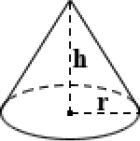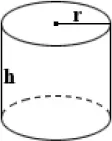Save time on math: surface area calculator
Leverage our easy-to-use calculator to accurately calculate surface area for various shapes, using your chosen measurement units.
Ball surface area
Radius (r)
meters

Cone surface area
Base Radius (r)
meters
Height (h)
meters

Cube surface area
Edge Length (a)
meters

Cylindrical tank surface area
Base Radius (r)
meters
Height (h)
meters

Rectangular tank surface area
Length (l)
meters
Width (w)
meters
Height (h)
meters

Capsule surface area
Base Radius (r)
meters
Height (h)
meters

Cap surface area
Please provide any two values below to calculate.
Base Radius (r)
meters
Ball Radius (R)
meters
Height (h)
meters

Conical frustum surface area
Top Radius (r)
meters
Bottom Radius (R)
meters
Height (h)
meters

Ellipsoid surface area
Axis 1 (a)
meters
Axis 2 (b)
meters
Axis 3 (c)
meters

Square pyramid surface area
Base Edge (a)
meters
Height (h)
meters

Surface area formulas
With our intuitive tool, quickly determine the surface of various solids. The applied formula varies based on the solid's nature, ensuring accurate results swiftly and effortlessly.
Surface area of a sphere
To determine the surface area of a sphere, you simply require its radius - or diameter. The formula for this calculation is A = 4 × π × r², with 'r' representing the sphere's radius.
Recognizing that the sphere's diameter equals twice the radius, i.e., d = 2r, the equation can be modified. So, it becomes A = 4 × π × (d / 2)², which tidies up to A = π × d². Here, 'd' is our diameter.
Surface area of a cube
Working out the surface area of a cube is a breeze. Picture this, each side of the cube is just a perfect square. A cube has six of these matching square faces. So, you multiply the area of one side by six:
A = 6 times the area of one side
And remember, the area of a square? It's simply the length of a side squared. So, our final, nifty formula for the surface area of a cube is:
A = 6 × l², with 'l' being the length of a side.
Surface area of a cone
The cone's surface area can be divided into two: the base (A(base) = π × r²) and the lateral area. The base is a circle, but the lateral area's calculation is less intuitive.
A(lateral) = π × r × √(r² + h²)
Let's unpack this a bit:
Unroll the cone's lateral surface to form a circular sector with radius s (the slant height of the cone). The sector's arc length is 2 × π × r, while the full circle's circumference is 2 × π × s.
The formula for the area of a sector, which represents the lateral surface of a cone, is:
A(lateral) = (s × (arc length)) / 2 = (s × 2 × π × r) / 2 = π × r × s
The formula is derived from proportions: shape areas are proportional to the arc length to the circumference:
(sector area) / (large circle area) = (arc length) / (large circle circumference) so:
(sector area) / (π × s²) = (2 × π × r) / (2 × π × s)
(sector area) = (π × s²) × (2 × π × r) / (2 × π × s)
A(lateral) = π × r × s
But what if we don't have the slant height, 's,' but instead the cone's height, 'h'? No worries! Pythagoras helps us out:
r² + h² = s², and taking the square root gives us s = √(r² + h²).
So, the formula for the lateral surface area becomes:
A(lateral) = π × r × √(r² + h²)
To obtain the final formula for the cone's surface area, simply sum the base and lateral areas.
A = A(lateral) + A(base) = π × r × s + π × r² given r and s or
A = π × r × √(r² + h²) + π × r² given r and h.
Surface area of a square pyramid
A pyramid is a 3D figure with a polygonal base and triangular sides. Often, we assume a pyramid is square-based, but it can have different bases, like hexagonal or rectangular. The surface area of a pyramid can be calculated using a formula:
A = l × √(l² + 4 × h²) + l² where l is the base side, and h is a height of a pyramid
Again, We can break down the equation:
A = A(base) + A(lateral) = A(base) + 4 × A(lateral face)
The base is square-shaped with area A(base) = l². For lateral surface area, consider one triangular face. To get the triangle's height, use the hypotenuse formula:
c = √(a² + b²)
Find the hypotenuse c of triangle ABC (also the height of the triangular face) using:
c = √(h² + (l/2)²) = √(h² + l²/4)
Calculate the area of our isosceles triangle by:
A = height × base / 2 so
A(lateral face) = √(h² + l²/4) × l / 2
The pyramid's surface area final formula is:
A = l² + 4 × √(h² + l²/4) × l / 2 = l² + 2 × l × √(h² + l²/4)
A = l² + l × √(4 × h² + l²)
Frequently Asked Questions
For surface area calculations, each shape has unique formulas. Here they are:
Cone: A = π2 + π(r2 + ℎ2)‾‾‾‾‾‾‾‾√, where r is the radius, and h is the height.
Cube: A = 6s2, with s as the side length.
Cylinder: A = πr2 + πrr2 + ℎ2‾‾‾‾‾‾‾√, where r is the radius, and h is the height.
Rectangular prism: A = 2(ab + bc + ac), with a, b, and c as side lengths.
Sphere: A = 4πr2, where r is the radius.
Use a surface area calculator for swift and precise outcomes.
When you're calculating surface area of a sphere, your first job is to find out the radius. For example, with a sphere of 10 cm radius we can apply this value to our mathematical formula.
A = 4πr²
Now, let's work out the math:
A = 4π × 10² = 1256 cm²
For a quicker and more accurate calculation of surface area, consider using an online tool.
Think of the surface area as the amount of space that the outside of an object takes up. Picture a 3D object - the surface area is all the space covered by its skin. Now, for some shapes, like pyramids or cylinders, you can split this 'skin' into two parts: the top and bottom (or base areas), and everything else around the sides, which we call the lateral surface area. This isn't really useful for objects where the sides and tops look the same, like cubes, or for perfectly round objects like spheres.

